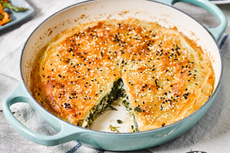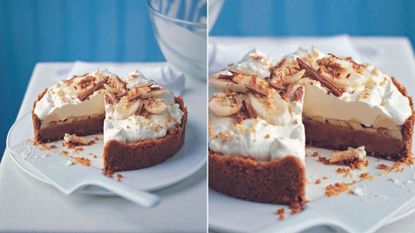
Is there any dessert more satisfying than a great banoffee pie? It’s such a classic that everyone loves, no guest will be disappointed when you serve it up.
So whether you’re entertaining friends for lunch this week or just want something extra special to treat the kids at the weekend, why not give this lovely dinner party dessert recipe a try this week?
It’s a great way to use up bananas you’ve got lingering in the kitchen – and the fruit contains serotonin as well as potassium and vitamin B6 to keep you feeling happy and healthy.
This recipe serves eight people and is actually really easy and quick to make so it’s a great one to just throw together if you’re in a hurry. The creamy but crunchy textures of the banana, biscuits and cream make for a wonderful dessert that won’t fail to put a smile on your face.
Ingredients
- 225g (8oz) digestive biscuits
- 150g (6oz) butter, melted
- 397g tin Nestlé Carnation Caramel or dulche du leche
- 3 bananas peeled and sliced
- 300ml (1/2pt) double cream
- 50g (2oz ) plain or milk chocolate, grated
You will also need:
- 23cm loose bottom flan tin or a cake tin for a deeper dish
Method
- Place the biscuits in a food processor and blitz to make fine crumbs.
- Melt the butter in a small pan then add to the biscuits and blitz until mixed.
- Press the mixture into a flan tin - or a cake tin for a deeper dish with plenty of the mixture up the sides. Press down well with the back of a wooden spoon. Place in the fridge and chill for at least 30 mins or until very firm
- Spread the caramel over the biscuit base. Arrange the banana slices over the toffee.
- Whip the cream and spread over the bananas. Top with the grated chocolate.
Jane Curran is a freelance food editor, stylist, writer and consultant based in Cape Town. Former food director of TI Media & woman&home. All about food, wine (dipWSET), gardening and the Arsenal.
-
 Chocolate coffee brownie mince pies
Chocolate coffee brownie mince piesTry a new spin on an old classic with these chocolate coffee brownie mince pies, the perfect blend of familiar, comforting, Christmas flavours with a crowd-pleasing chocolate and coffee twist
By Jen Bedloe Published
-
 Spanakopita (Greek spinach pie)
Spanakopita (Greek spinach pie)By Samuel Goldsmith Published
-
 Filo fish pie
Filo fish pieBy Jules Mercer Published
-
 Chocolate and hazelnut roulade
Chocolate and hazelnut rouladeThis chocolate and hazelnut roulade comes with an optional Baileys Irish cream liqueur filling for an extra, festive twist
By Jen Bedloe Published
-
 Baileys Cheesecake
Baileys CheesecakeThis no-bake Baileys cheesecake is so easy to make and perfect for cream liqueur lovers, plus it takes just 40 minutes to prepare
By Jess Meyer Published
-
 Chocolate torte with Baileys cream and salted praline
Chocolate torte with Baileys cream and salted pralineServe this rich Chocolate torte with Baileys cream and salted praline for a festive dessert that makes a popular alternative to Christmas pudding
By Jen Bedloe Published
-
 Kate Middleton’s favourite dessert is a decadent classic that she enjoys at cosy Berkshire pub
Kate Middleton’s favourite dessert is a decadent classic that she enjoys at cosy Berkshire pubThe Princess of Wales is said to love an indulgent British dessert and Prince William seemingly just confirmed it's her 'favourite'
By Emma Shacklock Published
-
 Queen Camilla’s got the right idea when it comes to sweet summer treats and we’re craving her last supper dessert right now
Queen Camilla’s got the right idea when it comes to sweet summer treats and we’re craving her last supper dessert right nowQueen Camilla's last supper dessert sounds decadent and refreshing all in one go and we want a huge bowl of it in this heatwave
By Emma Shacklock Published
-
 Kate Middleton's go-to order for a country pub lunch is a hearty three-course feast - and she chooses a classic for dessert
Kate Middleton's go-to order for a country pub lunch is a hearty three-course feast - and she chooses a classic for dessertThe Princess of Wales's picks for a pub lunch sound mouth-wateringly delicious
By Caitlin Elliott Published
